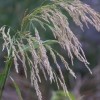Abstract
Sorghum-almum is a weak, perennial rhizomatous grass. Leaves of seedlings are rolled in a bud with a fringed membranous ligule. Seedlings often resemble corn seedlings when small. Stems of mature plants are stout and erect, reaching up to 14 feet tall. Leaf blades are flat and sandpapery. Sorghum-almum is commonly found in the southern part of Florida in sugarcane fields and along ditches, canals, and roadsides. This 3-page fact sheet was written by Dennis Calvin Odero, Ron Rice, and Les Baucum, and published by the UF Department of Agronomy, January 2013.
References
Eberlein, C.V. 1987. "Germination of Sorghum almum Seeds and Longevity in Soil." Weed Science 35:796-801. https://doi.org/10.1017/S0043174500079364
Paterson, A.H., K.F. Schertz, Y. Lin, S. Liu, and Y. Chang. 1995. "The Weediness of Wild Plants: Molecular Analysis of Genes Influencing Dispersal and Persistence of Johnsongrass, Sorghum halepense (L.) Pers." Proceedings of the National Academy of Sciences 92: 6127-31. https://doi.org/10.1073/pnas.92.13.6127
Southern Weed Science Society (SWSS). 1993 Weed Identification Guide. Champaign: Southern Weed Science Society.
United States Department of Agriculture, Natural Resources Conservation Service (USDA-NRCS). 2012. "Sorghum almum Parodi Columbus grass." Accessed November 27, 2012. http://plants.usda.gov/java/profilesymbol=SOAL.
Uva, R.H., J.C. Neil, and J.M. DiTomaso. 1997. Weeds of the Northeast. Ithaca: Cornell University Press.
Unless otherwise specified, articles published in the EDIS journal after January 1, 2024 are licensed under a Creative Commons Attribution-NonCommercial-NoDerivs 4.0 International (CC BY-NC-ND 4.0) license.

